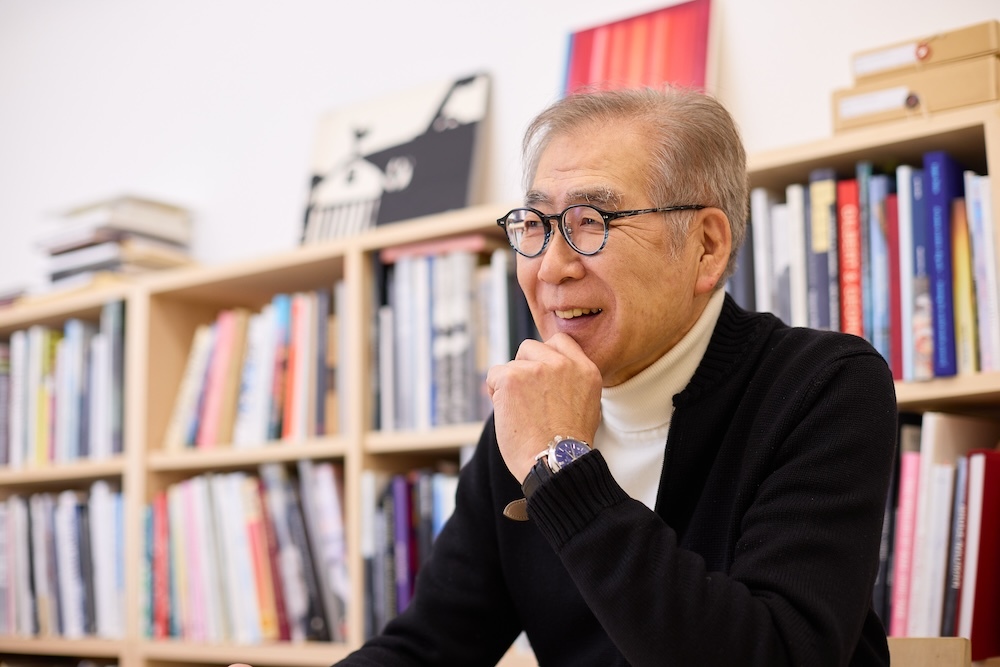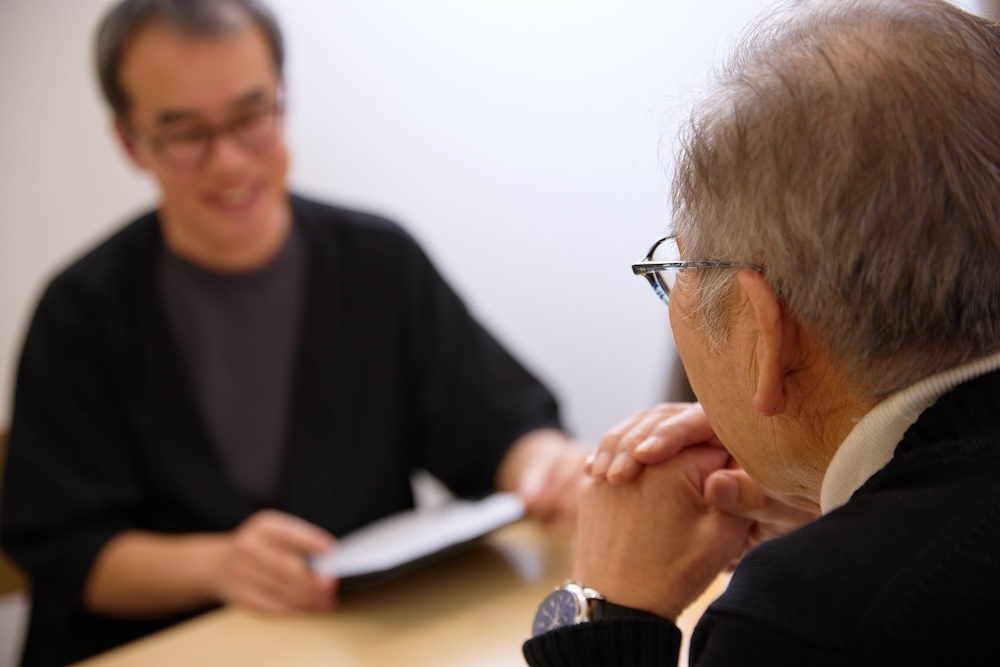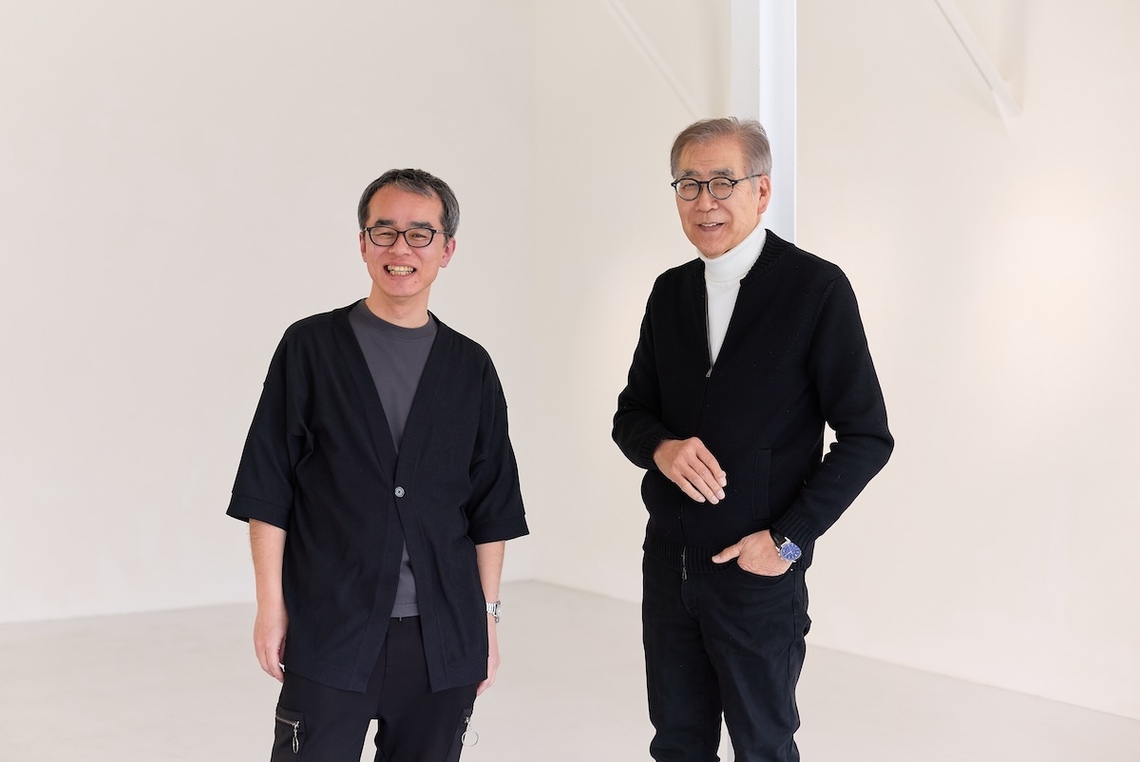Mr. Fumio Nanjo

Fumio Nanjo

Yutaka Miyagawa
Dentsu Inc.

A series by Dentsu Inc.'s Yutaka Miyakawa: "A Resident of the Marketing World Peeks into the World of Art."
This time, I had the pleasure of conversing with Fumio Nanjo. As an art critic and curator active on the world's leading frontlines, he is a driving force in the contemporary art scene. It's been over ten years since I first worked with Mr. Nanjo. I'm always drawn into his way of speaking, and before I know it, I find myself standing at the entrance to "the unknown." He encourages me to think for myself. Mr. Nanjo is a truly charming person.
◆The Appeal of Contemporary Art
Miyagawa: I get the impression that you, Mr. Nanjo, use various methods to bring even those unfamiliar with contemporary art to the point where they can become interested. But the real key lies beyond that point. You don't say, "You understand, right?" but rather, "No, I don't understand." I find that stance wonderful. Could you tell me again about what you consider the appeal of contemporary art?
Nanjo: I don't think the appeal of contemporary art is just one thing. There are socially critical works, and there are works where the artist expresses something deeply personal they've been holding inside. That very diversity is the charm; you can find something that resonates with you, something that clicks. The possibility of such encounters is also part of its appeal.
On the other hand, some find appeal in its market aspects. Just as some works see prices skyrocket, there's also the perspective of viewing contemporary art as an asset. Beyond that, there's the academic world, historical viewpoints... the world of contemporary art is truly iridescent.
So when you ask, "What is contemporary art?" the answer looks completely different depending on the person's position and perspective. Ultimately, no one really knows the true answer—and that uncertainty is part of the fun, isn't it?
Miyagawa: If you say you don't know, Nanjo-san, then surely no one does (laughs).
Nanjo: Exactly. I don't think there's any absolute yardstick that can definitively declare, "This is contemporary art." Even from a market perspective, contemporary art differs from other commodities in that its supply is inexhaustible. Real estate, diamonds, gold—they all have physical limits. But as long as someone keeps creating works, they never run out. That makes it interesting as a market too. Prices don't necessarily always rise, but new things are constantly emerging. In that sense, it also has economic appeal.
But then there are people like art critics who interpret works from an aesthetic standpoint, and these multi-layered interpretations intertwine. Contemporary art is truly an enigmatic entity.
Miyagawa: In an era that tends to seek definitive answers, contemporary art exists on the exact opposite vector.
Nanjo: Exactly. So, rather than seeking the right answer, what matters is expressing your own opinion – "What do I think?" This means the work doesn't just exist rigidly there; it exists in relation to you. Unless you think for yourself, the work won't start telling you anything. That's why viewing art is also a very human endeavor: "facing yourself."
As AI advances this far, the things humans should do keep dwindling. But in a way, that's wonderful, right? We're entering an era where we don't have to struggle like before. Precisely because of that, I think the role of contemporary art as one of the few remaining "human activities" will only grow larger from here on out.

◆Japan's Potential
Miyagawa: Given that, I can't help but wonder about Japan. What position does Japan hold in the world of contemporary art? There are various perspectives, like the relationship between Japanese education, values, and art. From your global perspective, Nanjo-san, how does Japan appear today?
Nanjo: Simply speaking about Japan's position in contemporary art, there aren't many countries that can list so many top-tier names: Yayoi Kusama, Yoshitomo Nara, Takashi Murakami, Hiroshi Sugimoto, Kohei Nawa, Izumi Kato. It's difficult to list the same caliber of artists from France or the UK, and even in the US, the number of globally influential contemporary artists is limited. Considering this, Japan is a highly influential "contemporary art powerhouse" on the international stage.
Miyagawa: Really? I get the feeling most Japanese people don't recognize Japan as a "contemporary art powerhouse."
Nanjo: But that's the reality. I think it's because Japan possesses a culture distinct from other nations. That distinctiveness becomes a resource for art. Everyone incorporates some "Japanese element" somewhere to gain recognition. Murakami consciously incorporates Japanese culture, and Sugimoto, while not speaking much about it, creates work that is profoundly Japanese.
In that sense, I believe Japan still has many cultural assets, a sort of "legacy," lying dormant. If we can utilize them effectively, there's ample potential for new works to continue emerging.
On the other hand, I also sense that Japan is a bit out of sync. There's an atmosphere where important themes that are commonly discussed in the West tend to be avoided here. This difference in urgency likely manifests itself in the works as well.
Miyagawa: Do you think this will change in the future?
Nanjo: That depends on people's curiosity, I suppose. I still think Japanese people should go out and see the world "with their own eyes" more. While people are coming to Japan from around the world lately, that doesn't really change Japanese perspectives. Unless you actively go out and experience the world's ecosystem firsthand, I don't think you can grasp what's happening now or the full picture of global values.

◆What I've Focused On Until Now
Miyagawa: Mr. Nanjo, you've served as director for numerous international art festivals, supervised renowned public and corporate art projects, and served as director of the Mori Art Museum. Your activities seem incredibly diverse. Do you have a consistent perspective guiding you?
Nanjo: I've just been hitting whatever came my way, you know (laughs). But I've always been conscious of balancing different types of work. For example, there are projects with academic or educational aspects, projects that generate solid profits, and projects carrying social meaning or messages. I think working while considering the balance between these types is how a person should be.
Miyagawa: That's a perspective that resonates with businesspeople too. We tend to focus too much on profits alone, but your approach—balancing that with social significance—feels exactly what's needed right now.
Nanjo: You often hear it in the business world too, right? "Creating a win-win relationship is important." My thinking might be similar. For example, even academic projects can't operate at a complete loss. It's vital to create work that has social significance while also generating proper fees. When I handled the public art for Shinjuku Island, I assembled major artists, but the following year's project introduced works by young Japanese artists. Both projects had academic and educational significance while also being economically viable.
When we held the performance event "Act and Creation" at the Japan Foundation in 1982, the budget came from theater-related funds. So we invited top-tier contemporary artists like Daniel Buren to perform, setting up the event as a "performance" showcase. That was a "twisted" strategy.
Miyagawa: The process of assigning value to something that everyone still fails to recognize—that's precisely the Nanjō style of undertaking, isn't it?
Nanjo: Exactly. The fact that people knew so little about it became an advantage. Back in the 1980s, understanding of contemporary art in Japan was really shallow. Art criticism was dominated by information-driven commentary from people who hadn't even seen the actual works. But contemporary art absolutely requires seeing the "real thing" to be meaningful. That's why, at a certain point, I decided to become the one who "brings it in." I planned exhibitions and curated authentic, cutting-edge contemporary art. I believed that if I did that, Japanese people would surely start thinking, "Contemporary art is interesting."
Miyagawa: The genre-crossing exhibitions you organized at the Mori Art Museum were precisely the kind of setup designed to spark people's curiosity, weren't they?
Nanjo: Yes. As I said at the beginning, contemporary art is fundamentally something that can't be defined, right? So, even if you point to a work and say, "This is contemporary art," it's just dancing within the confines of preconceived notions. You need to cross that border and place what everyone thinks of as art alongside things from other fields. I believed we should present various things in a borderless situation, with an attitude of "There's also this kind of thing, right?" and "What about this possibility?"

◆Corporate Engagement with Contemporary Art
Miyagawa: So far, we've focused on individual perspectives. Now, I'd like to ask about the significance of organizations utilizing contemporary art from a "corporate" viewpoint.
Nanjo: Years ago, when the precursor to Art Fair Tokyo was held in Yokohama, I contributed a piece on "Business and Art" for the accompanying book. In it, I wrote, "Japan has this monster called 'corporation.'" Essentially, corporations increase profits but fail to adequately return value to employees or society, instead funneling that money into further investments. I raised the issue that there's a structure where enormous profits remain trapped within the corporate vessel, leaving people fundamentally unhappy. And fundamentally, once a company turns a profit, it should contribute to culture. Only by doing so can a company be recognized as a "meaningful presence" within society.
Miyagawa: That's quite a strong message.
Nanjo: Then, some time later, I got a phone call. Mr. Soichiro Fukutake of Benesse had apparently read that article and said, "Come see me. I want to meet you." That was the catalyst for me curating the first exhibition on Naoshima (1994). Mr. Fukutake utilized contemporary art for Benesse's branding, but it also resulted in a significant contribution to culture.
Miyagawa: That's a very symbolic initiative.
Nanjo: Occasionally, you encounter executives with a philosophical perspective, both domestically and internationally. For example, the former president of Hermès was often called a "philosopher." When I actually met him, he was quiet and had that philosopher-like demeanor. Hermès became a unique brand under him. I get the impression that people who possess this way of thinking—going beyond the idea of simply making and selling things, transcending boundaries, and viewing the world from a bird's-eye perspective—also have a deep understanding of contemporary art.
Miyagawa: What about companies operating globally, like financial institutions?
Nanjo: There are certainly companies that are quite advanced in this area. For example, Switzerland's UBS Group is the main sponsor of Art Basel, and Deutsche Bank and Chase Manhattan also hold large contemporary art collections. For these companies, art is not merely about branding; it's also seen as part of communication and customer service, particularly with their executive-level clientele.

◆Marketers (and Business Professionals) and Contemporary Art
Miyakawa: Finally, shifting the perspective back to the individual, I'd like to ask about the significance of engaging with contemporary art from the standpoint of a "marketer." Among those reading this series, many likely think, "I want to broaden my horizons" or "I want to acquire cultural literacy beyond narrowly defined marketing." I hope to convey the fascination and richness of engaging with contemporary art to such readers. What are your thoughts?
Nanjo: I truly believe marketing, at its core, must be creative. What really stuck with me was the stance of Mercedes-Benz, as described by Mr. Tokudaiji Yutaka (author of "The Car Buyer's Guide").
Typically, manufacturers research market needs and build cars to meet them, right? But Mercedes doesn't do that. They start with a vision of "this is how a car should be," and then build cars to realize that vision. Safety, comfort, performance... They pursue these to the extreme, then take the stance: "It's expensive, but this is the ultimate car." In other words, they define and propose their own value. I think this attitude is precisely the direction marketing should be heading. Simply researching the market isn't enough. What do you propose beyond that? That's where true creativity is required, and I believe it's one thing we can learn from contemporary art.
Miyagawa: Exactly. It's about the ability to say, "This is how I see it," rather than asking, "What's the right answer?" It connects back to the art discussion earlier.
Nanjo: An AI expert once said, "AI can paint in Van Gogh's style." But Van Gogh's essence lies in his leap beyond the history of painting that preceded him. He was influenced by ukiyo-e, eliminating shadows and painting with flat color planes. He severed the long, continuous history and lineage of Western art that had been meticulously built up until then, creating an entirely new form of expression. I questioned whether AI could achieve such a "leap." The professor then said, "AI can create strange things. But it's humans who decide whether it's 'art.'" This applies beyond art—what's essential for making judgments is one's own "sensibility" and "values," and honing them is crucial. Isn't that the significance of engaging with contemporary art?
Miyagawa: Even if you're not an artist, drawing inspiration from artists' visionary perspectives can help each person elevate themselves or expand business possibilities, right?
Nanjo: Art is ultimately about the very act of perception itself. Throughout history, from Sen no Rikyū to Marcel Duchamp and on to contemporary artist Hiroshi Sugimoto today, there have always been people who overturned conventional ways of seeing things.
What Rikyū did shares the same conceptual approach as Duchamp's conceptual art. At a time when many revered white porcelain tea bowls imported from China as beautiful, Rikyū found beauty in the distorted black tea bowls made by tile artisans—specifically, Raku ware. In doing so, he completely overturned the prevailing values of "what is beauty?"
In a film about Rikyu, there's a scene where a samurai confronts him, demanding, "Why is this bowl so expensive? Does it truly have value?" Rikyu replies, "If I say it does, then it does." This is a powerful expression of confidence: "Value is something you decide for yourself." That's exactly the same stance as modern art. Declaring an object whose value might not be immediately apparent as "this is art." By holding firm to that conviction, it truly begins to gain value and leaves its mark on history.
If that is the core of art, then it is precisely creativity itself, and it can be seen as a training ground for cultivating a flexible perspective. I think the recently discussed "art thinking" also speaks to the importance of such flexible thinking.
Miyagawa: So, through engaging with art, we can cultivate the ability to perceive things and discover value.
Nanjo: Exactly. There's no such thing as a fixed value. You decide how you see it and have confidence in that. The ability to do that might be the quality that allows people to find contemporary art interesting.
Furthermore, while there's no inherent definition of contemporary art, if we define it as extremely creative work—much like Joseph Beuys named socially transformative actions "social sculpture"—then it transcends painting and sculpture. Marketing work, daily tasks, even thought processes can be contemporary art if they're creative. That perspective is essential for our times.
Miyagawa: I see. Rather than forcing it into the box of "contemporary art," it's important to see it as something continuous with work and daily life.
Nanjo: So to put it bluntly, contemporary art probably doesn't exist.
Miyagawa: Hearing you say "contemporary art doesn't exist" makes me flinch (laughs). But it's true—recently, contemporary art seems to be crossing boundaries and blending into all sorts of areas.
Nanjo: Exactly. Anything creative has the potential to be contemporary art.
Miyagawa: For marketers too, engaging with art might open new perspectives by expanding their thinking to encompass their own sensibilities, ideas, and actions. Thank you for your valuable insights today!

Image Production: Satoshi Iwashita
Was this article helpful?
Newsletter registration is here
We select and publish important news every day
For inquiries about this article
Back Numbers
Author

Fumio Nanjo
Graduated from Keio University's Faculty of Economics in 1972 and the Department of Philosophy, Faculty of Letters, specializing in Aesthetics and Art History, in 1977. After working at the Japan Foundation and other institutions, joined the founding team of the Mori Art Museum in 2002. Served as Director from November 2006 to 2019 and has been Special Advisor since 2020. Also serving as General Advisor to Towada Art Center since 2020, Special Assistant Director to Hirosaki Renga Soko Museum of Art, and appointed Special Director of Arts Maebashi in May 2023. Since the late 1990s, he has curated major international exhibitions including the Japan Pavilion at the 1997 Venice Biennale, the 1998 Taipei Biennale, the 2001 Yokohama Triennale, the 2006 and 2008 Singapore Biennale, the 2016 Ibaraki North Art Festival, the 2017 Honolulu Biennale, the 2021 Kitakyushu Future Creation Art Festival ART for SDGs, and Fuji Textile Week (2021–2023). Publications include Living with Art (Kadokawa Shoten, 2012).

Yutaka Miyagawa
Dentsu Inc.
After the Great East Japan Earthquake, I began to feel a desire to reflect on Japanese culture and future generations.




